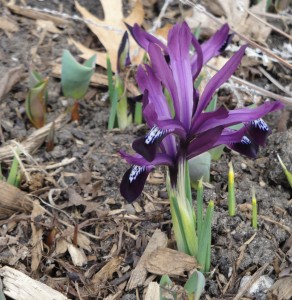 Today I spotted this lovely Iris reticulata, which has always been a harbinger of spring, blooming in my garden. This is the fourth time I have noted this bloom on the blog, and not surprisingly given our strange weather, the earliest. Last year, I first saw Iris reticulata in bloom on April 4; in 2010, I saw it on March 25; and in 2009, I recorded it blooming on April 16. So that puts us two to four weeks ahead of schedule — at least by iris time.
Today I spotted this lovely Iris reticulata, which has always been a harbinger of spring, blooming in my garden. This is the fourth time I have noted this bloom on the blog, and not surprisingly given our strange weather, the earliest. Last year, I first saw Iris reticulata in bloom on April 4; in 2010, I saw it on March 25; and in 2009, I recorded it blooming on April 16. So that puts us two to four weeks ahead of schedule — at least by iris time.
I should note that while this bulb is up and blooming, I don’t even see foliage yet for the Siberian squill I have naturalized in the lawn and in another bed. My neighbor’s crocus — another plant I monitor as a sign of spring — are also not blooming yet. In the past, these other plants were blooming about the same time as the iris.
I’m not sure what — if anything — to draw from that. It could be the lack of rain is affecting the other plants more than the iris, which is in one of the beds I water most as well as a place where we pile snow from the walk.
A day or two of 70s in March is not totally out of sync with “normal” for Minnesota. But, according to the weather dudes, it is likely we will have almost 10 days in a row of severely above normal temperatures — that’s just plain weird. (The average high for Minneapolis in March is 41, rising to 58 in April. Average lows are generally still in the 20s.)
I find the whole weather pattern disconcerting. There are big picture issues like increased numbers of severe weather incidents and, of course, the drought here. But there are also smaller ones such as how this early, extended warmth will affect my cherry and apple trees. If they bloom, then are zapped by a frost (remember, this is still Minnesota), that will be the end of the crop. I’m sure orchardists in Minnesota are watching their trees carefully, but what can you do to protect them from weather in the 70s? Perennials will likely recover, even if they are frost burned; and we can always plant more vegetables or just hold off until the “proper” planting time.
I’ve listened to some entomologists and horticulturists talk about the effect of an early spring on plants and insects and the experts seem to think the bees, the bugs and the plants can figure this all out better than we humans can. Bugs may hatch earlier and some of them may get caught in a frost. Bees tend to time their spring emergence with the arrival of blooms. Some pests will probably thrive in the warmth, while others will struggle.
This post is a bit rambling, but I’m a bit lost on how to think about this warm, lovely, frightening spring. What are you seeing blooming in your yard? And, what concerns do you have about a too-early spring? Or, are you just enjoying the warm weather?
Hi Mary,
I came across your site via a Google search and thought you might be interested in my UK based Phenology blog.
Kind Regards
Tony Powell
Thanks, Tony. I find phenology fascinating, and given the weather around here, it may be all we gardeners have to go on!